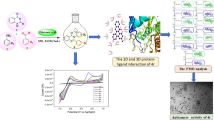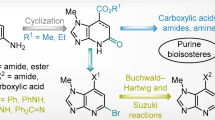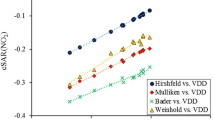Abstract
The derivatives of 1,2,4- triazole have attracted great attention among medicinal chemists due to their wide range of biological activity, good pharmacodynamic and pharmacokinetic profiles, and low toxicity, that necessitates the development of various synthesis methods and a comprehensive study of their reaction mechanisms. A detailed investigation of possible pathways for formation of new spiro-condensed [1,2,4]triazolo[1,5-c]quinazolines, that combine two structural domains with different biological properties, was performed by computational study at the SMD/B3lyp/6-31+G(d) theory level. The mechanism of interaction between [2-(3-hetaryl-1,2,4-triazol-5-yl)phenyl]amine and cyclohexanone in methanol involves three main processes: formation of carbinolamine by addition of an amine to double bond C=O, elimination of a water molecule, and intramolecular cyclization leading to formation of spiro compounds. Results show increase in reactivity of reactants during acid-catalyzed reaction compared to uncatalyzed one. The nature of the heterocyclic substituent on the triazole ring has little effect on the reaction energy, while the mechanism is unchanged.







Similar content being viewed by others
Data availability
The data supporting the findings of this study are available within its supplementary material and from the corresponding author on reasonable request.
References
Kazeminejad Z, Marzi M, Shiroudi A, Kouhpayeh SA, Farjam M, Zarenezhad E (2022) Novel 1, 2, 4-triazoles as antifungal agents. Biomed Res Int 2022:1–39. https://doi.org/10.1155/2022/4584846
Maddila S, Pagadala R, Jonnalagadda BS (2013) 1, 2, 4-triazoles: a review of synthetic approaches and the biological activity. Lett Org Chem 10:693–714. https://doi.org/10.2174/157017861010131126115448
Kaur P, Chawla A (2017) 1, 2, 4-triazole: a review of pharmacological activities. Int Res J Pharm 8:10–29. https://doi.org/10.7897/2230-8407.087112
Kapron B, Luszczki JJ, Plaziska A, Siwek A, Karcz T, Grybos A, Bowak G, Makuch-Kocka A, Walczak K, Langner E, Szalast K, Marciniak S, Paczkowska M, Cielecka J, Ciesla LM, Plech T (2019) Development of the 1, 2, 4-triazole-based anticonvulsant drug candidates acting on the voltage-gated sodium channels. Insights from in-vivo, in-vitro, and in-silico studies. Eur J Pharm Sci 129:42–57. https://doi.org/10.1016/j.ejps.2018.12.018
Gao F, Wang T, Xiao J, Huang G (2019) Antibacterial activity study of 1, 2, 4-triazole derivatives. Eur J Med Chem 173:274–281. https://doi.org/10.1016/j.ejmech.2019.04.043
Othman AA, Kihel M, Amara S (2019) 1, 3, 4-oxadiazole, 1, 3, 4-thiadiazole and 1, 2, 4-triazole derivatives as potential antibacterial agents. Arab J Chem 12:1660–1675. https://doi.org/10.1016/j.arabjc.2014.09.003
Shahzad SA, Yar M, Khan ZA, Shahzadi L, Naqvi SAR, Mahmood A, Ullah S, Shaikh AJ, Sherazi TA, Bale AT, Kukulowicz J, Bajda M (2019) Identification of 1, 2, 4-triazoles as new thymidine phosphorylase inhibitors: Future anti-tumor drugs. Bioorg Chem 85:209–220. https://doi.org/10.1016/j.bioorg.2019.01.005
El-Sherief HAM, Youssif BGM, Bukhari SNA, Abdelazeem AH, Abdel-Aziz MA-RHM (2018) Synthesis, anticancer activity and molecular modeling studies of 1, 2, 4-triazole derivatives as EGFR inhibitors. Eur J Med Chem 156:774–789. https://doi.org/10.1016/j.ejmech.2018.07.024
Wittine K, Babic MS, Makuc D, Plavec J, Pavelic SK, Sedic M, Pavelic K, Leyssen P, Neyts J, Balzarini J, Nintas M (2012) Novel 1, 2, 4-triazole and imidazole derivatives of L-ascorbic and imino-ascorbic acid: synthesis, anti-HCV and antitumor activity evaluations. Bioorg Med Chem 20:3675–3685. https://doi.org/10.1016/j.bmc.2012.01.054
Zhang S, Xu Z, Gao C, Ren QC, Chang L, Lv ZS, Feng LS (2017) Triazole derivatives and their anti-tubercular activity. Eur J Med Chem 138:501–513. https://doi.org/10.1016/j.ejmech.2017.06.051
Jin RY, Zeng CY, Liang XH, Sun XH, Liu YF, Wang YY, Zhou S (2018) Design, synthesis, biological activities and DFT calculation of novel 1, 2, 4-triazole Schiff base derivatives. Bioorg Chem 80:253–260. https://doi.org/10.1016/j.bioorg.2018.06.030
Xu J, Cao Y, Zhang J, Yu S, Chai X, Wu Q, Zhang D, Jiang Y, Sun Q (2011) Design, synthesis and antifungal activities of novel 1, 2, 4-triazole derivatives. Eur J Med Chem 46:3142–3148. https://doi.org/10.1016/j.ejmech.2011.02.042
Fan YL, Ke X, Li M (2018) Coumarin–triazole hybrids and their biological activities. J Heterocycl Chem 55:791–802. https://doi.org/10.1002/jhet.3112
Mishra SS, Singh P (2016) Hybrid molecules: the privileged scaffolds for various pharmaceuticals. Eur J Med Chem 124:500–536. https://doi.org/10.1016/j.ejmech.2016.08.039
Hu YQ, Gao C, Zhang S, Xu L, Xu Z, Feng LS, Wu X, Zhao F (2017) Quinoline hybrids and their antiplasmodial and antimalarial activities. Eur J Med Chem 139:22–47. https://doi.org/10.1016/j.ejmech.2017.07.061
Amin KM, Anwar MM, Syam YM, Khedr M, Kamel MM, Kassem EMMA (2013) A novel class of substituted spiro[quinazoline-2,1’-cyclohexane] derivatives as effective ppar-1 inhibitors: molecular modeling, synthesis, cytotoxic and enzyme assay evaluation. Acta Pol Pharm Drug Res 7:687–708
Mustazza C, Borioni A, Sestili I, Sbraccia M, Rodomonte A, Ferretti R, Rosaria Del Giudice M (2006) Synthesis and evaluation as NOP ligands of some spiro[piperidine-4,2’(1’H)-quinazolin]-4’(3’H)-ones and spiro[piperidine-4,5’(6’H)-[1,2,4]triazolo[1,5-c]quinazolines]. Chem Pharm Bull 54:611–622. https://doi.org/10.1248/cpb.54.611
Antypenko OM, Kholodnyak SV, Schabelnyk KP, Antypenko LM, Kovalenko SI (2017) 2-(Azolyl) anilines: methods of synthesis, cyclocondensations, and biological properties. Chem Heterocycl Comp 53:292–309. https://doi.org/10.1007/s10593-017-2051-7
Kehler J, Ritzen A, Langgard M, Petersen SL, Farah MM, Bundgaard C, Christoffersen CT, Nielsen J, Kilburn JP (2011) Triazoloquinazolines as a novel class of phosphodiesterase 10A (PDE10A) inhibitors. Bioorg Med Chem Lett 21:3738–3742. https://doi.org/10.1016/j.bmcl.2011.04.067
Antipenko LN, Karpenko AV, Kovalenko SI, Katzev AM, Komarovska-Porokhnyavets EZ (2009) Synthesis, cytotoxicity by bioluminescence inhibition, antibacterial and antifungal activity of ([1,2,4]Triazolo[1,5-c]quinazolin-2-ylthio)carboxylic acid amides. Arch Pharm Chem Life Sci 342:651–662. https://doi.org/10.1002/ardp.200900077
Wesseler F, Lohmann S, Riege D, Halver J, Roth A, Pichlo C, Weber S, Takamiya M, Muller E, Ketzel J, Flegel J, Gihring A, Rastegar S, Bertrand J, Baumann U, Knippschild U, Peifer C, Sievers S, Waldmann H, Schade D (2022) Phenotypic discovery of Triazolo[1,5-c]quinazolines as a first-in-class bone morphogenetic protein amplifier chemotype. J Med Chem 65:15263–15281. https://doi.org/10.1021/acs.jmedchem.2c01199
Zeydi MM, Montazeri N, Fouladi M (2017) Synthesis and evaluation of novel [1,2,4]Triazolo[1,5-c]quinazoline derivatives as antibacterial agents. J Heterocycl Chem 54:3549–3553. https://doi.org/10.1002/jhet.2979
Kovalenko SI, Antypenko LM, Bilyi AK, Kholodnyak SV, Karpenko OV, Antypenko OM, Mykhaylova NS, Los TI, Kolomoets OS (2013) Synthesis and anticancer activity of 2-(alkyl-, alkaryl-, aryl-, hetaryl-)-[1, 2, 4] triazolo [1, 5-c] quinazolines. Sci Pharm 81:359–391. https://doi.org/10.3797/scipharm.1211-08
Kholodnyak SV, Schabelnyk KP, Voskoboynik OYu, Antypenko OM, Кovalenko SI, Palchykov VO, Okovyty SI, Shishkina SV (2016) 5,6-dihydro-[1,2,4]triazolo[1,5-c]quinazolines. message 4. Spirocompounds with [1,2,4]triazolo[1,5-c] quinazolines moieties. The synthesis and spectral characteristics. J Org Pharm Chem 14:24–31
Cmikiewicz A, Gordon AJ, Berski S (2018) Characterisation of the reaction mechanism between ammonia and formaldehyde from the topological analysis of ELF and catastrophe theory perspective. Struct Chem 29:243–255. https://doi.org/10.1007/s11224-017-1024-x
Hall NE, Smith BJ (1998) High-level ab initio molecular orbital calculations of imine formation. J Phys Chem A 102:4930–4938. https://doi.org/10.1021/jp9810825
Ding Y, Cui Y, Li T (2015) New views on the reaction of primary amine and aldehyde from DFT study. J Phys Chem A 119:4252–4260. https://doi.org/10.1021/acs.jpca.5b02186
Silva PJ (2020) New insights into the mechanism of Schiff base synthesis from aromatic amines in the absence of acid catalyst or polar solvents. PeerJ Org Chem 2:1–4. https://doi.org/10.7717/peerj-ochem.4
Solís-Calero C, Ortega-Castro J, Hernàndez-Laguna A, Muñoz F (2012) Reaction mechanism of covalent modification of phosphatidylethanolamine lipids by reactive aldehydes 4-hydroxy-2-nonenal and 4-oxo-2-nonenal. Theor Chem Acc 131:1–12. https://doi.org/10.1021/acs.chemrestox.6b00443
Ortega-Castro J, Adrover M, Frau J, Salvà A, Donoso J, Muñoz F (2010) DFT studies on Schiff base formation of vitamin B6 analogues. Reaction between a pyridoxamine-analogue and carbonyl compounds. J Phys Chem A 114:4634–4640. https://doi.org/10.1021/jp909156m
Qu ZW, Zhu H, Zhukova NA, Katsyuba SA, Mamedov VA, Grimme S (2021) Mechanistic insights for acid-catalyzed rearrangement of quinoxalin-2-one with diamine and enamine. ChemCatChem 13:1503–1508
Frisch MJ, Trucks GW, Schlegel HB, Scuseria GE, Robb MA, Cheeseman JR, Scalmani G, Barone V, Mennucci B, Petersson GA, Nakatsuji H, Caricato M, Li X, Hratchian HP, Izmaylov AF, Bloino J, Zheng G, Sonnenberg JL, Hada M, Ehara M, Toyota K, Fukuda R, Hasegawa J, Ishida M, Nakajima,T, Honda Y, Kitao O, Nakai H, Vreven T, Montgomery JrJA, Peralta JE, Ogliaro F, Bearpark M, Heyd JJ, Brothers E, Kudin KN, Staroverov VN, Kobayashi R, Normand J, Raghavachari K, Rendell A, Burant JC, Iyengar SS, Tomasi J, Cossi M, Rega N, Millam JM, Klene M, Knox JE, Cross JB, Bakken V, Adamo C, Jaramillo J, Gomperts R, Stratmann RE, Yazyev O, Austin AJ, Cammi R, Pomelli C, Ochterski JW, Martin RL, Morokuma K, Zakrzewski,VG, Voth GA, Salvador P, Dannenberg JJ, Dapprich S, Daniels AD, Farkas O, Foresman JB, Ortiz JV, Cioslowski J, Fox DJ( 2009) Gaussian 09, Revision A.01. Gaussian Inc., Wallingford
Becke ADJ (1993) Density-functional thermochemistry.3.The role of exact exchange. Chem Phys 98:5648–5652
Hehre WJ, Radom L, Schleyer PR, Pople JA (1986) Ab initio molecular orbital theory. Wiley, New York
Marenich AV, Cramer CJ, Truhlar DG (2009) Universal solvation model based on solute electron density and on a continuum model of the solvent defined by the bulk dielectric constant and atomic surface tensions. J Phys Chem B 13:6378–6396. https://doi.org/10.1021/jp810292n
Pylypenko OO, Okovytyy SI, Sviatenko LK, Voronkov EO, Shabelnyk KP, Kovalenko SI (2023) Tautomeric behavior of 1, 2, 4-triazole derivatives: combined spectroscopic and theoretical study. Struct Chem 34:181–192. https://doi.org/10.1007/s11224-022-02057-0
Funding
The authors declare that no funds, grants, or other support were received during the preparation of this manuscript.
Author information
Authors and Affiliations
Contributions
OP calculated and interpreted data and was a contributor in writing the manuscript. LS calculated and interpreted data and was a contributor in writing the manuscript. KS was a contributor in writing the manuscript. SK was a contributor in writing the manuscript. SO interpreted data and was a contributor in writing and editing the manuscript. All authors read and approved the final manuscript.
Corresponding author
Ethics declarations
Conflict of interest
The authors have no relevant financial or non-financial interests to disclose.
Additional information
Publisher's Note
Springer Nature remains neutral with regard to jurisdictional claims in published maps and institutional affiliations.
Supplementary Information
Below is the link to the electronic supplementary material.
214_2024_3110_MOESM1_ESM.docx
SMD/B3lyp/6-31+G(d) modeled pathways for acid-catalyzed reaction of 2-(3-(thiophen-2-yl)-1,2,4-triazol-5-yl)anilines and 2-(3-(pyrrol-2-yl)-1,2,4-triazol-5-yl)anilines with cyclohexanone in methanol along with the corresponding Gibbs free energy diagram (DOCX 4789 kb)
Rights and permissions
Springer Nature or its licensor (e.g. a society or other partner) holds exclusive rights to this article under a publishing agreement with the author(s) or other rightsholder(s); author self-archiving of the accepted manuscript version of this article is solely governed by the terms of such publishing agreement and applicable law.
About this article
Cite this article
Pylypenko, O.O., Sviatenko, L.K., Shabelnyk, K.P. et al. Reaction of [2-(3-hetaryl-1,2,4-triazol-5-yl)phenyl]amines with ketones: a density functional theory study. Theor Chem Acc 143, 35 (2024). https://doi.org/10.1007/s00214-024-03110-3
Received:
Accepted:
Published:
DOI: https://doi.org/10.1007/s00214-024-03110-3




